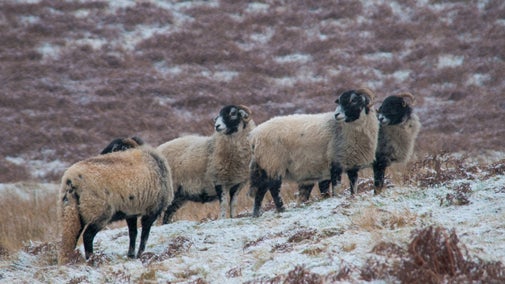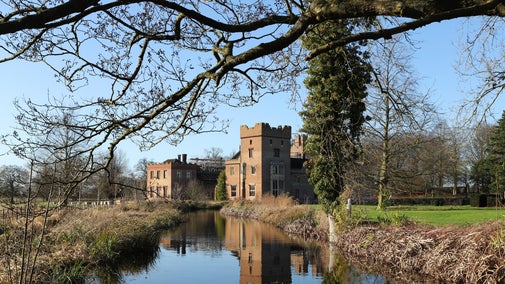
Donate
Everyone needs nature, now more than ever. Donate today and you could help people and nature to thrive at the places we care for.

There is no such thing as a typical day when it comes to work in the Buttermere Valley – rangers could be doing anything from working with volunteers to repair gates or leading school visits to dealing with researchers and designing conservation projects. Find out how we’re not only protecting this special place, but helping it to thrive too.
Our forestry team regularly assesses the health of the woodlands in our care and put together thorough management plans to either keep them thriving or increase their health and resilience. The work often involves thinning out areas of woodland to help bring more light to the undergrowth and to give more space to the older trees to grow bigger and stronger. Any wood harvested is used locally to help reduce our carbon footprint on much needed projects in the area.
In January 2023, we starting work on felling larch trees in Holme Wood and surrounding woodlands to stop the spread of Phytophthora Ramorum. This work was done in accordance with a Statutory Plant Health Notice issued by the Forestry Commission. Working with the local community, we have taken all necessary precautions to protect our wildlife such as red squirrels and badgers which call Holme Wood home. We also made sure to miss the prime bird nesting season by completing works at this time.
The paths have now been reinstated so all may once again have access to the woodland. Over the winter months, we replanted with hardy native trees as well as letting some areas regenerate naturally with the benefit of new light reaching the ground in the spaces left by the larch.
Hedgerows have a massive visual effect on the landscape, but they’re also great for wildlife, providing corridors of shelter and food for all sorts of birds and small mammals.
By laying a hedge we are essentially regenerating the trees, allowing continuity in the hedgerow. In this way we can keep that hedge working for much longer than its natural lifetime. Without this regeneration the hedge will mature and start to die.
Hedge laying is something we can only do in winter when the sap is not running through the stems.
– Paul Delaney, North Lakes Ranger
While hedge laying styles vary from county to county, the local one is called ‘West Cumberland’ – and it’s fair to say it is not to everyone’s taste. Essentially, it strips the trees out to single shorn stems which are then laid flat to the ground.
For a few months the hedge disappears, but because there’s lots of light, there’s fantastic regrowth. The nature corridor is maintained while the landscape value is only slightly and temporarily diminished, and it also enables a degree of efficiency.
Flower-rich hay meadows are rare these days and yet they’re such an important habitat, sustaining diverse wildlife from invertebrates to songbirds. As part of our work at Buttermere, we’re helping these meadows to thrive.
In the lakeshore meadow there’s no use of fertilisers or cow muck as this could cause too many nutrients to get into the water, which is detrimental to the health of the lake.
On this patch of land we can identify at least six species of grass which provide the bulk of the crop in a meadow system, but also many broad-leaved herbs such as red clover, knapweed, eye bright, autumn hawksbit, sorrel and great burnet.
Closer to the water, the species come in marshier varieties such as water mint, spearwort and ragged robin.
In the water itself are water lobelia; this is an indication that the ‘no cows rule’ is working because water lobelia only grows in low nutrient tarns.

Further from the lake is a hay meadow. It’s also unfertilized but this field does see some ‘muck-action’. To the untrained eye this field looks much the same as the last, however, there's lots more yellow rattle and eyebright.
This is a traditional hay meadow in progress and although they can take a very long time to develop, it’s easy to see how small change in usage can make for a difference species profile.
In other areas, a system of natural grazing using livestock is used by the rangers to encourage the meadows to thrive.
Grasses flourish when munched upon, as their growth comes from the base and not from the tip like the broad-leafed herbs.
Unlike the hay meadow above, it’s grazed year-round apart for approximately 10 weeks when the stock is fenced away from the water.
There’s not a lot of deep peat in the Lake District, but High Nook Tarn and onto Whiteoak Moss is one of the places where this special habitat can be found.
The whole area is cut with deep gullies, holes and ‘peat pipes’ where old drainage systems have allowed water to run underneath the peat causing areas of slippage. The vegetation has a habit of hiding this damage from the unwary.
Star moss and sphagnum moss are the very stuff of peat formation and there’s plenty to see up here, including cranberries, bilberries galore and the odd tuft of cotton grass.
Controlling the amount of grazing on this bog is important to help keep it ecologically sustainable.
While Whiteoak Moss has been slowly improving over the last 20 years, more time and careful management will allow it to flourish with even more spongey mosses, cotton grass and flowering plants such as bog asphodel.
Exclosures are experimental pieces of land, sectioned off so that grazing livestock cannot get onto them. Through these we can monitor what effect this has on flora and fauna.
Inside the exclosure, we’ve so far noticed several improvements including:
A satisfactory result gives a window into the future for the whole area, if grazing can continue to be reduced over time.
We work with external agencies like United Utilities who extract water from the lakes and the Environment Agency to look at the rivers we manage.
Natural England work with us to discuss the condition of the Sites of Special Scientific Interest (SSSI) that we protect and how we can get them to even better condition.
We also issue universities with licences for their research studies – this could be anything from moth surveys to taking core samples from lake-bed sediment or examine the effects of flooding.

A big part of our work at Buttermere Valley is also community relations, making sure there are good links to the parish council.
Unfortunately we also have to deal with a small minority who come to wild camp but end up creating damage to farmer’s gates, leaving broken glass, and even discarding burned tents on the lakeshore.
Answering visitors’ questions and helping them get the most out of their day is a key part of what we do.
We’re also working with schools to try and make sure the next generation of people growing up in West Cumbria have a better understanding of their environment and how conservation work can improve it for the future.
– Mark Astley, valley ranger for Buttermere Valley
We work with big events companies who want to run sporting events on the land we look after. It’s a fine balance between making amazing experiences possible for large numbers of people, without it having a negative impact on the landscape they’re here to enjoy.
Buttermere Valley is upstream of Cockermouth, so part of our conservation work is helping to enable rivers that have been artificially straightened in the past to function more naturally, to provide better wildlife habitats and more natural flood resilience.
That includes working with tenant farmers to fence off river courses to allow natural vegetation to recover. These create buffer zones between any nitrogen spread on the fields and the river system. The vegetation also stabilises the banks and makes them less vulnerable to erosion.
The woodlands of the Buttermere Valley are covered with charcoal pit steads and sites ranging from bronze age burial mounds to World War Two defences designed to stop enemy seaplanes landing on the lakes.
Keeping the sites clear of trees helps to protect them from damage from tree roots, while rerouting paths helps protect archaeological sites from damage.
With your ongoing support, we're able to continue our vital conservation work. Thank you for helping to protect these special places.

Everyone needs nature, now more than ever. Donate today and you could help people and nature to thrive at the places we care for.
Explore the Lake District's Buttermere Valley and discover walks through rugged landscapes, panoramic views, thundering waterfalls and other forces of nature.

Discover the wildlife you can spot in the Buttermere Valley. Learn how otters have returned and how rangers care for swathes of bluebells to protect them for future generations.

Find out how to get boating and fishing permits for the lakes of Buttermere, Crummock and Loweswater before your visit.

We believe that nature, beauty and history are for everyone. That’s why we’re supporting wildlife, protecting historic sites and more. Find out about our work.

Read about our strategy, which focuses on restoring nature, ending unequal access and inspiring more people.

Holme wood is just one of many areas which has been affected by tree disease which threaten our precious woodlands throughout the country. Managing the spread through targeted felling and re-planting of hardier native species will ensure the future of our forests.

Learn about the traditional farming practices in the Lake District and how the National Trust works with farm tenants to restore vital habitats, protect wildlife and support quality local produce.
